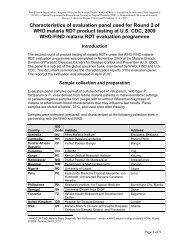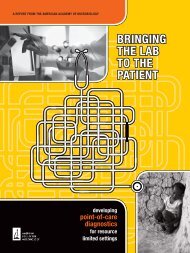Round 1 - Foundation for Innovative New Diagnostics
Round 1 - Foundation for Innovative New Diagnostics
Round 1 - Foundation for Innovative New Diagnostics
You also want an ePaper? Increase the reach of your titles
YUMPU automatically turns print PDFs into web optimized ePapers that Google loves.
1. Executive Summary<br />
differentiate P. falciparum from non-P. falciparum malaria 1 ,<br />
and 3 detect P. falciparum and non-P. falciparum malaria<br />
without distinguishing between them. Manufacturers<br />
submitted 2 lots of each product <strong>for</strong> evaluation.<br />
1.1. Introduction<br />
The World Health Organization estimates that 3.3 billion<br />
persons were at risk of acquiring malaria in 2006, with 247<br />
million of these developing clinical malaria (86% in Africa),<br />
and nearly 1 million (mostly African children) dying from<br />
the disease. Malaria remains endemic in 109 countries, and<br />
while parasite-based diagnosis is increasing, most suspected<br />
cases of malaria are still not properly identified, with<br />
accurate diagnosis and disease monitoring consequently<br />
remaining elusive (1).<br />
WHO recommends that malaria case management be<br />
based on parasite-based diagnosis in all cases, with the<br />
exception of young children in areas of high transmission<br />
and where lack of resources or need <strong>for</strong> urgent response<br />
temporarily limits its application. The use of antigendetecting<br />
rapid diagnostic tests (RDTs) <strong>for</strong>ms a vital part<br />
of this strategy, providing the possibility of parasite-based<br />
diagnosis in areas where good quality microscopy can not<br />
be maintained. The number of RDTs available, and the scale<br />
of their use, has rapidly increased over the past few years.<br />
However, limitations of comparative field trials and the<br />
heterogeneous nature of malaria transmission has limited<br />
the availability of good quality per<strong>for</strong>mance data that<br />
national malaria programmes require to make in<strong>for</strong>med<br />
decisions on procurement and implementation. To this end<br />
in 2006, WHO and FIND (<strong>Foundation</strong> <strong>for</strong> <strong>Innovative</strong> <strong>New</strong><br />
<strong>Diagnostics</strong>) launched an evaluation program to assess the<br />
per<strong>for</strong>mance of commercially available malaria RDTs and<br />
allow direct product comparisons that would assist WHO,<br />
other UN agencies and national governments in making<br />
procurement decisions and would ultimately encourage<br />
improvement in the quality of manufacturing.<br />
1.2. The WHO Product Testing<br />
Programme<br />
This report, which presents the results of the first round of<br />
WHO product testing of malaria antigen-detecting RDTs, was<br />
completed in November 2008 in collaboration with FIND, the<br />
US Centers <strong>for</strong> Disease Control and Prevention (CDC) and<br />
other partners (Fig.2). All companies manufacturing under<br />
ISO-13485 Quality System Standard were invited to submit<br />
up to 3 tests <strong>for</strong> evaluation under the programme. In this<br />
first round of testing, 41 products from 21 manufacturers<br />
were evaluated against prepared blood panels of cultured<br />
Plasmodium falciparum parasites and patient-derived P.<br />
falciparum and P. vivax parasites, and a parasite-negative<br />
panel. Thermal stability was assessed after 2 months<br />
of storage at elevated temperature and humidity, and a<br />
descriptive ease of use assessment was recorded. Of the<br />
41 products, 16 detect P. falciparum alone, 22 detect and<br />
The evaluation is designed to provide comparative data<br />
on the per<strong>for</strong>mance of the submitted production lots of<br />
each product. Such data will be used to guide procurement<br />
decisions of WHO and other UN agencies and national<br />
governments. Product testing is part of a continuing<br />
programme of work to improve the quality of RDTs that<br />
are used, and to support broad implementation of reliable<br />
malaria diagnosis in areas where malaria is prevalent. A<br />
second round of product testing began in April 2009. It is<br />
anticipated that a further round will be undertaken in 2010,<br />
with a call <strong>for</strong> expressions of interest later in 2009.<br />
1.3. Results of the Evaluation<br />
The results (summarized in Tables 3, 3a, 4, 4a and Figure E1)<br />
provide comparative data on 2 lots of products against a<br />
panel of parasite samples diluted to a low parasite density<br />
(200 parasites/μL) and a higher parasite density (2000 or<br />
5000 parasites/μL). The <strong>for</strong>mer is below the mean parasite<br />
density found in many populations with endemic malaria.<br />
For the purposes of this report, 'detection rate' of a product<br />
is the percentage of malaria samples in the panel giving<br />
a positive result by two RDTs per lot at the lower parasite<br />
density, and a single RDT per lot at the higher parasite<br />
density. Thus, it is not a measure of RDT clinical sensitivity,<br />
or positivity rate against the panel but rather a combined<br />
measure of positivity rate, along with inter-test and interlot<br />
consistency.<br />
The clinical sensitivity of an RDT to detect malaria is highly<br />
dependent on the local conditions, including parasite<br />
density, in the target population, and so will vary highly<br />
between malaria-endemic populations. The results in this<br />
report show comparative per<strong>for</strong>mance between RDTs, and<br />
give an idea of which products are likely to provide higher<br />
sensitivity in the field, particularly in populations with lowdensity<br />
infections. As the detection rate at 2000 parasites/<br />
μL indicates, the sensitivity of many of these products will<br />
be similar in populations with higher parasite densities,<br />
although a subset of any population will include vulnerable<br />
individuals who may develop illness at low parasite densities<br />
(e.g. young children, pregnant women, those well protected<br />
by bed nets) and must always be taken into account when<br />
interpreting RDT results.<br />
Heat stability (summarized in Table 5) is vital to maintaining<br />
sensitivity of the test in the field. As a result, <strong>for</strong><br />
procurement, it is essential that careful consideration be<br />
given to stability results to ensure that products to be used<br />
in areas with high temperatures of transport and storage<br />
have demonstrated great stability in the product testing<br />
programme. Requirements will vary between countries:<br />
<strong>for</strong> example, if tests are to be deployed in areas where<br />
temperatures rarely rise above 30 ° C, less emphasis needs to<br />
be placed on stability at high temperatures.<br />
1 One is P. vivax specific<br />
Malaria Rapid Diagnostic Test Per<strong>for</strong>mance – Results of WHO product testing of malaria RDTs: <strong>Round</strong> 1 (2008)<br />
1


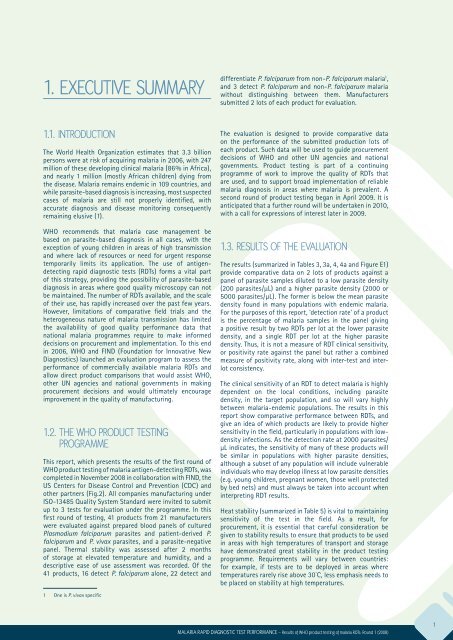

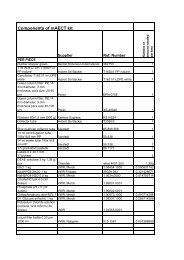
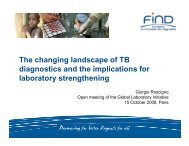
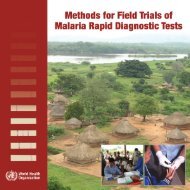
![Download in English [pdf 2Mb] - Foundation for Innovative New ...](https://img.yumpu.com/49580359/1/184x260/download-in-english-pdf-2mb-foundation-for-innovative-new-.jpg?quality=85)

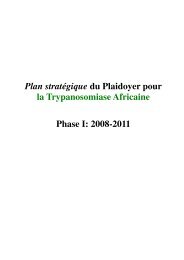
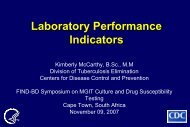
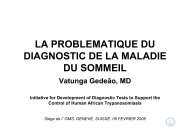
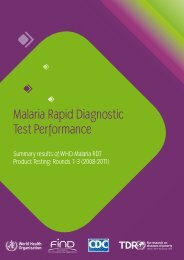
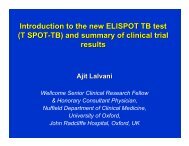
![New laboratory diagnostic tools for tuberculosis control [.pdf]](https://img.yumpu.com/43339906/1/190x135/new-laboratory-diagnostic-tools-for-tuberculosis-control-pdf.jpg?quality=85)
